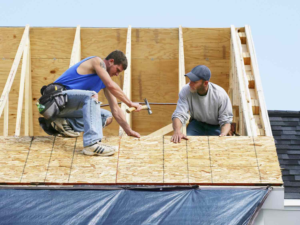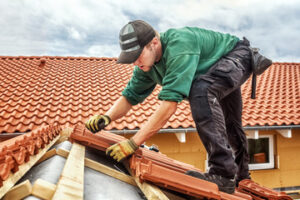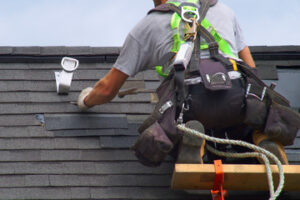Erie Shingles protects your home from the elements and adds value to it. There are many different types of shingles to choose from.
3-tab shingles are the most basic type of asphalt shingle. They are single-layered and have a repetitive pattern. They are affordable but lack durability compared to other options.

1. Durability
The longevity of roof shingles depends on the materials and style chosen. The thickness of the shingle is an important factor, as thicker shingles provide superior protection against harsh weather conditions. Standard three-tab shingles, for instance, aren’t nearly as durable as 30- or 50-year architectural shingles.
The material and color of your shingles also impact how long they last. A lighter colored shingle, for example, may reflect heat away from the home and help lower energy costs. But keep in mind that each type of shingle has unique heat transfer properties and absorbs sunlight differently.
Wood shingles are made from naturally durable woods, such as cedar and redwood, that can add a rustic charm to your house. They can withstand harsh weather conditions, but they do require regular maintenance to prevent moisture buildup and insect damage. Over time, wood shingles develop a beautiful patina that enhances their aesthetic and accentuates their ruggedness.
Clay and concrete shingles are the roofing staples of Mediterranean Europe, Latin America, and the Southwestern United States. They can last for decades and offer a classic look that enhances your curb appeal and raises your home’s resale value. They also offer excellent weather resistance and can withstand high winds, heavy rains, and other environmental factors that shorten the lifespan of other roofing materials.
Asphalt shingles can last for close to 20 years, depending on the materials and construction quality. A proactive approach to shingle maintenance and timely repairs, performed by a professional roofing contractor, can significantly lengthen the lifespan of these durable protectors.
2. Aesthetics
The color of your roof shingles can enhance or diminish the aesthetics of your home. It’s essential to choose a color that complements the architectural style of your home and other exterior features, such as siding colors and brick shades. Additionally, coordinating shingle colors with the surrounding landscape can help your home blend in for a visually appealing effect. It’s also important to consider if your neighborhood has HOA guidelines or other regulations that might impact shingle color selection.
The granules that cover the asphalt shingle serve several purposes, including providing UV protection and increasing fire resistance. They also improve the appearance of your roof, as they create an attractive, speckled look. Many shingle manufacturers offer a wide range of color options to enhance the aesthetics of your roof.
While 3-tab shingles are the most basic type of shingle, dimensional shingles offer an enhanced appearance and increased durability. These shingles feature a unique design, with alternating areas of single and double layers. They’re also thicker than 3-tab shingles and easier to install.
Other shingle types, such as curved eaves and fishscale shingles, are available to add distinctive architectural elements to your home. For example, curved eaves allow you to create rolling curves for your home’s eaves and gables, ideal for a cottage-style house. Fishscale shingles have rounded ends that resemble scales, which complement the aesthetic of Tudor Revival-style homes and English cottages.
Other shingles are designed for specific climates. For instance, hail-resistant shingles are popular in hail-prone regions and help protect your roof from damage. Additionally, cool shingles offer more reflectivity to reduce temperatures in your attic and potentially lower energy bills. Choosing the right shingle style for your home is a complex decision that involves taking into account the architectural style of your house, your budget, and other considerations.
3. Energy efficiency
Roofing is one of the most important parts of a home, protecting it from rain and regulating temperature. A good roof helps increase the resale value of your home and reduces energy costs by reflecting solar heat instead of absorbing it. A good quality shingle is also durable and easy to maintain, so you can count on it to protect your house for decades.
A roof’s color is an important part of its energy efficiency, with light colors reflecting more sunlight and heat than dark ones. However, many shingles now come with energy-efficient features that aren’t restricted to lighter colors. Manufacturers have created new lines of shingles that use reflective granules to improve the shingle’s SRI (Solar Reflective Index) and help reduce your energy bills. You can find these shingles in any color, including some darker shades that typically have lower SRI values.
Another way to improve your roof’s energy efficiency is by installing insulation. This will help keep your home cool in the summer and warm in the winter, reducing your need for HVAC use. Insulation also adds value to your home, adding to its resale value and improving its overall comfort.
In addition to choosing the right roofing material for your home, you can make your home more energy efficient by adding extra insulation and ensuring that it is properly vented. By combining these techniques with an energy-efficient shingle like GAF Timberline HDZ RS Shingles, you can create a high-performance roof that looks great and saves money.
4. Weather resistance
Roof Shingles are a durable roofing option, protecting your home from severe weather conditions. They are also designed to withstand algae growth, making them resistant to water penetration and preventing the formation of mold. As a result, the durability of these shingles provides a significant return on investment and a lasting aesthetic for your home.
Asphalt shingles are generally classified as Class 3 — meaning they can resist moderate hail damage, although it’s best to consult with your DaBella professional about the specific impact resistance of the shingle that will work best for your home. If you live in an area prone to frequent hailstorms, we recommend upgrading to impact-resistant shingles. This will not only protect your roof from damage, but it may help you qualify for a reduction in your homeowners’ insurance premium.
A quality impact-resistant shingle is manufactured with high-grade materials that can withstand hail and other flying debris that might damage conventional shingles. This helps to reduce the risk of roof leaks and structural damage that can lead to expensive repairs or even a full roof replacement.
Many impact-resistant shingles are also rated to reflect heat, improving your roof’s energy efficiency and helping to lower your utility bills. Additionally, they are more durable than regular shingles, which can save you money on roof maintenance and repair costs.
Another type of shingle is the premium/designer shingle, which offers a more distinct aesthetic than standard asphalt shingles. These shingles are made to replicate the look of historic natural roofing styles like slate tiles and cedar shakes, providing an elegant finish for your roof. These shingles come in a variety of colors and shapes to complement your design aesthetic and elevate your home’s curb appeal.
5. Value
The cost of roof shingles can vary considerably based on material choice, brand reputation and labor costs. However, the quality and durability of a shingle roof make it an excellent investment that can protect your home for decades and help boost its resale value.
Choosing the right shingle type for your home is an important decision that you should consult with a professional roofing specialist to help ensure you get the best product at the best price. A quality shingle roof will provide superior protection to your property and significantly reduce energy costs for a long time to come.
Asphalt shingles are the most popular shingle roofing option, but there are many different types of shingles available for all needs and budgets. Three-tab shingles, for example, offer an affordable option that resists wind up to 60 MPH and comes with a 15-year algae resistance warranty.
Other asphalt shingle varieties include architectural and luxury shingles that offer differentiated aesthetics and functionality. Luxury shingles are crafted to emulate the appearance of visually stunning natural roofing materials like cedar and slate for a fraction of the price. These shingles are also fire resistant and can last up to 50 years.
The price of shingles has increased in recent months due to rising raw material prices and labor shortages in the construction industry. This is most evident in the cost of shingle bundles, which have skyrocketed by nearly 10% this year alone.
The height and pitch of your roof can also impact the installation and replacement prices for a shingle roof. Steeper roofs are more challenging to work on and require extra safety equipment to use, which can increase the overall project costs.

